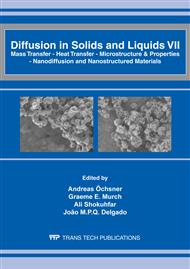[1]
T.G. Gutowski, M.S. Branham, J.B. Dahmus, A.J. Jones, A. Thiriez and D.P. Sekulic: Thermodynamic Analysis of Resources Used in Manufacturing Processes. Environmental Science & Technology Vol. 43 (2009), p.1584.
DOI: 10.1021/es8016655
Google Scholar
[2]
P.I. Collier and A. Ornek: A mathematical model for energy and in-process inventory assessment in a manufacturing system. Applied Energy Vol. 13 (1983), p.265.
DOI: 10.1016/0306-2619(83)90019-3
Google Scholar
[3]
C. Herrmann and S. Thiede: Process chain simulation to foster energy efficiency in manufacturing. CIRP Journal of Manufacturing Science and Technology Vol. 1 (2009), p.221.
DOI: 10.1016/j.cirpj.2009.06.005
Google Scholar
[4]
G. -B. Hong, C. -M. Ma, H. -W. Chen, K. -J. Chuang, C. -T. Chang and T. -L. Su: Energy flow analysis in pulp and paper industry. Energy Vol. 36 (2011), p.3063.
DOI: 10.1016/j.energy.2011.02.051
Google Scholar
[5]
L. Liu, Lu Aye, Zhongwu Lu and Peihong Zhang: Effect of material flows on energy intensity in process industries. Energy Vol. 31 (2006), p.1870.
DOI: 10.1016/j.energy.2005.07.003
Google Scholar
[6]
H. Wu, H. Jouhara, S.A. Tassou and T.G. Karayiannis: Modelling of energy flows in potato crisp frying processes. Applied Energy. In Press, Corrected Proof.
DOI: 10.1016/j.apenergy.2011.01.008
Google Scholar
[7]
M. Teresa Torres, M. Carmen Barros, Pastora M. Bello, Juan J. Casares and J. Miguel Rodriguez-Blas: Energy and material flow analysis: Application to the storage stage of clay in the roof-tile manufacture. Energy Vol. 33 (2008), p.963.
DOI: 10.1016/j.energy.2007.09.008
Google Scholar
[8]
A. Al-Ghandoor, P.E. Phelan, R. Villalobos and J.O. jaber: Energy and exergy utilizations of the U.S. manufacturing sector. Energy Vol. 35 (2010), p.3048.
DOI: 10.1016/j.energy.2010.03.046
Google Scholar
[9]
S. Kara, S. Manmek, and C. Herrmann: Global manufacturing and the embodied energy of products. CIRP Annals - Manufacturing Technology Vol. 59 (2010), p.29.
DOI: 10.1016/j.cirp.2010.03.004
Google Scholar
[10]
S. Kara and S. Ibbotson: Embodied energy of manufacturing supply chains. CIRP Journal of Manufacturing Science and Technology. In Press, Corrected Proof.
DOI: 10.1016/j.cirpj.2011.03.006
Google Scholar
[11]
T. Melton: The Benefits of Lean Manufacturing: What Lean Thinking has to Offer the Process Industries. Chemical Engineering Research and Design Vol. 83 (2005), p.662.
DOI: 10.1205/cherd.04351
Google Scholar
[12]
K.A. Rosentrater and R. Balamuralikrishna: Value stream mapping - a tool for engineering and technology education and practice., in ASEE IL/IN Conference (2006), Fort Wayne.
Google Scholar
[13]
F.A. Abdulmalek and J. Rajgopal: Analyzing the benefits of lean manufacturing and value stream mapping via simulation: A process sector case study. International Journal of Production Economics Vol. 107 (2007), p.223.
DOI: 10.1016/j.ijpe.2006.09.009
Google Scholar
[14]
M. Branham, T.G. Gutowski, A. Jones and D.P. Sekulic: A thermodynamic framework for analyzing and improving manufacturing processes. in Electronics and the Environment, 2008. ISEE 2008. IEEE International Symposium (2008).
DOI: 10.1109/isee.2008.4562892
Google Scholar
[15]
D. Zheng, R. Yao, and H. Jin: Thermodynamic methodology of energy-flow framework diagram for technical energy systems. Energy Vol. 29 (2004), p.2473.
DOI: 10.1016/j.energy.2004.03.027
Google Scholar


